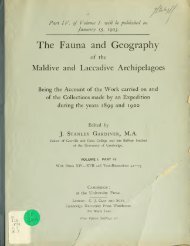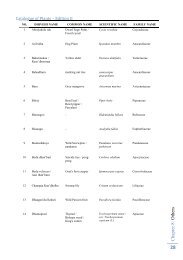Download - WordPress – www.wordpress.com
Download - WordPress – www.wordpress.com
Download - WordPress – www.wordpress.com
You also want an ePaper? Increase the reach of your titles
YUMPU automatically turns print PDFs into web optimized ePapers that Google loves.
670 K. C. PUNNETT.gonad spells increased bulk and in the absence of a specialized vascular system this increaseof bulk must be almost entirely dependent on increased length. For respiration would dependon transepidermal diffusion, a process which would more readily occur in a long slenderanimal than in a short thick one. This great elongation of the gonad would necessitatethe establishment of accessory ducts by which its products could readily and rapidly escape.From this it is but a short step to the stage of a series of independent gonads each withits own duct extending throughout the elongated trunk region—a condition physiologically<strong>com</strong>parable to that now found among the Nemerteans. Increase of bulk will still meanincreased fertility and such individuals will be fovoured by Genetic Selection\ provided alwaysthat the means for ensuring due aeration are adequate, whence we <strong>com</strong>e to the establishmentof dermal pits for the aeration of the gonads. Later the pits be<strong>com</strong>e perforated and nodoubt these perforations supplied a physiological need and filtered off the excess of waterfrom the sand passing through the animal's alimentary canal. Probably it was somewherenear this phylogenetic ejaoch that the ancestral Enteropneusts took to an arenicolous life.The problem of extraction of nutriment from a relatively enormous mass of innutritionssubstance resulted in the specialization of the middle and hinder part of the digestive tract,and the establishment of the hepatic caeca led to the disappearance of the gonads in thisregion. They have left traces of their former presence in the epidermal annulations whichshew some tendency to irregularity now that their determining cause has disappeared; theyare still found in a rudimentary state in the hepatic region of some forms, but increasedphysiological specialization has on the whole led to their confinement to the more anteriorportions of the trunk.BIBLIOGRAPHY.'86. Bateson, W. " Development of Balanoglossm Kovalevskii," Quart. Journ. Mic. Sc.Vol.XXVI.'98. Delage and Herouard. Traite de Zoologie Concrete, Vol. viii. Les Procorde's.'94. Hill, J. P. " On a new .species of Enteropneusta from the coast of New SouthWales," Proc. Linn. Soc. N.S.W. Vol. x.'98. Hill, J. P. "The Enteropneusta of Funafuti," Memoirs Au-'it. Mas. in.'85. HuBRECHT, A. A. W. Proeve eener ontwikkelingsgeschiedenis van Linens obscurus. Utrecht.'02. KuwANO, H. " On a new Enteropneust from Misaki, Balanoglossus misakiensis, n. sp."Annot. Zool. Jap. Vol. IV.'94. Morgan, T. H. "The Development o{ Balanoglossus," Journ. Morph.'OO. RiTTER, W. E. "Harriinania maculosa," Proc. Wash. Acad. Sc. Vol. ii.'02. RiTTEK, \V. E. " The movements of the Enteropneusta," Biol. Bull. Vol. ill.'93. Spengel, J. W. "Die Enteropneusten," Naples Monograph.'Ol. Spengel, J. W. "Die Benennung der Enteropneusten-Gattungen," Zool. Jahr. Vol. xv.Syst.Abt.'03. Spengel, J. W. " Neue Beitrage zur Kenntniss der Enteropneusten," Zool. Jahr.Vol. xviii. Anat. Abt.'99. Willey, a. "Enteropneusta from the South Pacific, etc.," Willey's Zoological Results,Pt. 3.1Cf. Pearson, K., The Grammar of ScU'iicn. 1900, p. 437, and also The Chances of Death, etc., 1897, Vol. i. p. C3(Eseaj on Reproductive Selection).






